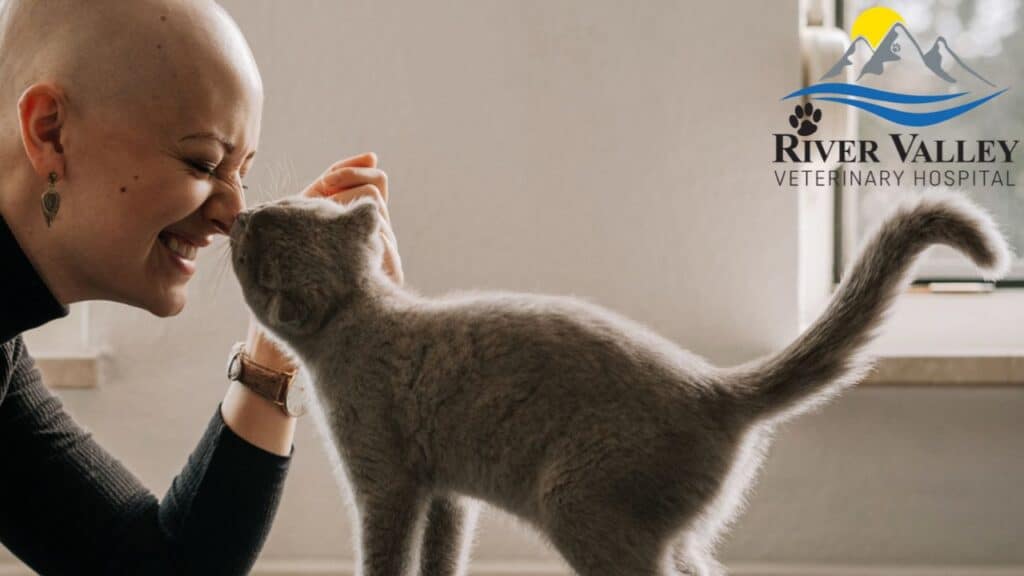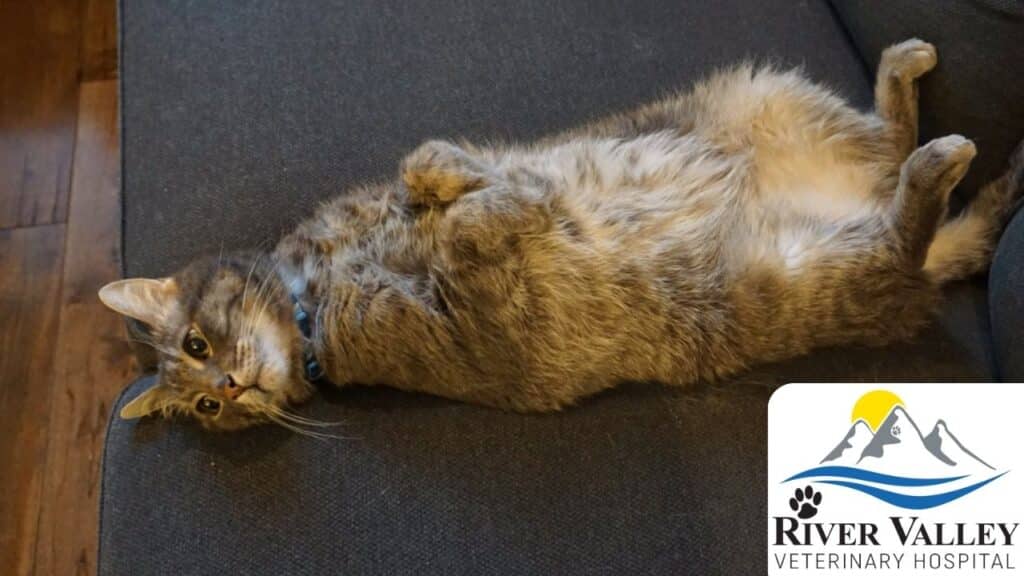Veterinarian Fox Chapel | What Is Your Cat Telling You Part Three
In part one and two of What Is Your Cat Telling You, with Dr. Linkenheimer from veterinarian Fox Chapel, we learned how cats communicate. In addition to vocalizing, your cat talks with their body as well. Despite cats having a bad reputation for having hard to read body language, with some time, you too can learn how to read your pet’s behaviours and body language.
Then you can understand how your cat is feeling, what they want and help ensure they bond effectively with their furry feline family member. This article discusses what tail and body position mean.
So what is your cat telling you? The cat’s tail can be a very obvious sign of their mood, says veterinarian Fox Chapel clinic owner, Dr. Linkenheimer. However, since they do not move their tail the same way that a dog does, some people have a hard time reading what a cat is indicating with their tail. (https://www.hillspet.ca/en-ca/cat-care/behavior-appearance/cat-tail-language) While so many more people are familiar with what dog’s tails indicate, once learned, a cat’s tail can be a powerful indicator as well.

Arched Back Versus Flat Back
Generally speaking, a happy and confident cat has their tail lifted vertically. It’s a flag, sending the signal that it welcomes interactions! The tip of your cats tail may twitch, which indicates they’re happy. However, watch your cats body language, a raised tail with an arched back and puffed out fur can indicate they are potentially aggressive, such as a strange cat wandered into your yard – the cat’s territory. Check their body language and use context to figure out what your cat is saying.
Body position of the cat is paramount to understanding what they are saying. A happy, confident cat will have a flat back. If they are interested in interactions, says veterinarian Fox Chapel, their body will be positioned towards you. A fearful cat will make themselves look as small as possible, and crouch themselves into a ball. This helps them hide from what they are fearful of, but this position helps them spring to action quickly, if they feel a need to, such as running to a better hiding place.
What to do around a scared cat
The best thing to do with a fearful cat is leave them alone. Ensure your home has hiding places for your cat, so they can feel secure. Stick to the same routine, and when your cat is ready, they’ll come out. If your cat is routinely hiding with no specific threat, this could be an indication of stress and anxiety. If after keeping the same routine for a while, your cat is still exhibiting these behaviours, contact Dr. Linkenheimer and team at veterinarian Fox Chapel clinic. They can often help your cat stop being so anxious.
If your cat is arching their back, with their hair puffed out – a phenomena known as pilo-erection. They are trying to make themselves look as large as possible, meaning they are potentially aggressive, and are at least ready to stand their ground and fight, if the perceived threat does not immediately leave. An aggressive cat will also likely stand sideways, indicating a readiness to fight. This should not be confused however, with a cat stretching in relaxation. It may look similar but there are key differences, says veterinarian Fox Chapel owner, Dr. Linkenheimer.
Veterinarian Fox Chapel | The Body Position of Your Cat
A cat stretching in relaxation will have their front paws outstretched, their very back end will be what’s raised, and the cat will often have closed, or mostly closed eyes. Their hair will not be standing on end. While a scared or aggressive cat will have more of the middle of their back arched, their eyes will be wide, they will be standing sideways to the perceived threat, and their hair will be puffed up.
Cat owners should always pay attention to what direction their cat’s body is facing. It will always point their body in the direction they want to go. When the cat’s body is facing you, they want interaction with you. A cat with arched back stands sideways to the threat, because they are ready to run off in a different direction to escape if needed.
Do Cats Like Belly Rubs?

Finally, the cutest body position of a cat that you’ll see is the outstretched cat. They may be laying on their side, or their back. The indicator of this position is if they are leaving their belly exposed. This indicates that a cat feels not only comfortable, but safe with you.
A cat will usually only expose their belly when they are at ease, and know that there is no threat to them. However, people who think this is an invitation for a belly rub, will be in for a surprise says Dr. Linkenheimer of River Valley Veterinary Hospital, the best veterinarian Fox Chapel. A relaxed cat may not want their belly rubbed, especially because cats can quite quickly become overstimulated, since the belly and tail hair follicles are hyper sensitive.
Make sure your cat is comfortable with you
The general rule of thumb is get to know your cat first, and understand how long they can tolerate a belly rub before you go in for a scritch, says Dr. Linkenheimer the veterinarian Fox Chapel owner. However, in some circumstances, the cat is on their back, because it’s the most effective method of deploying all four paws with claws. In different contexts, this position means the cat is ready to fight – or play.
Again, look at all to understand what your cat is saying. Interestingly enough, many of the same types of body language found in the domesticated housecat are also found in the large cats. The seven big cats include lions, tigers, jaguars, leopards (including snow leopard), cougar and cheetah. And the smaller large cats like pumas, lynx, bobcat, ocelot and more also display many of the same behaviours and body language!
In the next article, Dr. Linkenheimer of veterinarian Fox Chapel discusses with us how to further decipher what is your cat telling you, more specifically what a cat means with their ears and eyes. This will help you get one step closer to knowing what your furry feline friend is thinking and feeling. If you have any questions in the mean time, the staff at River Valley Veterinary Hospital will be more than happy to do a meet and greet, and answer all of your questions.
